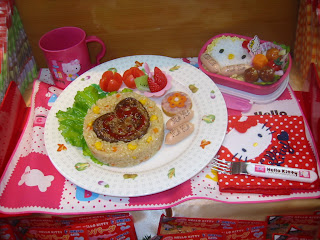The first item I made was Coq Au Vin (p. 431). Coq Au Vin is one of those dishes that has always intimidated me--I know it's just chicken cooked with wine but its fancy name always makes it seem difficult to make. I know that the dish is supposed to be made with an old co...rooster (I would giggle too much if I used the other term) or spent hen but, as I don't keep chickens in my backyard (much to my dog's dismay), I had to settle for chicken thighs from the grocery store. I always default to chicken thighs when TJOC specifies "chicken parts" because I think they are FAR more flavorful and juicy than chicken breasts and easier to eat than legs.
Plus they are cheap. Wonderfully cheap.
You know a recipe is going to be tasty when it starts by asking for bacon. Ummm....bacon... I cut bacon using my kitchen shears because bacon can be difficult to cut with a knife. I didn't have thick-cut bacon so I estimated the ounces of my normal-cut bacon.

I can never figure out what kind of skillets or pots TJOC thinks we have. I can't fit 3.5-4.5 lbs of chicken in any of my pots or pans and it always takes several batches...

I happily started to make my onion/carrot mixture--no problem, made that a thousand times. I add all the ingredients and get ready to add the wine...

I go to add the 3 cups of dry red wine. Obviously, this is an important part of the recipe--I mean, it's in the title. Josh and I don't tend to drink at home, so when I buy wine to cook with, it sits around for a while. I made Stracotto again (it was even more delicious this time because I cooked in less) and was under the impression that I had enough wine for both dishes. As you probably have figured out from the beginning of that sentence, it was a wrong impression.
I pour the wine into a measuring cup. It's only one cup. Crap.
I look in the refrigerator--there is a bottle of red in there! I taste it--it tastes fine to me (I'm no wine expert) so I measure it. One more cup. Crap. And of course it's not the same type of wine as the first.
So I look in the cupboard. No more red wine--but I have a bunch of the little bottles of white (I prefer these for cooking). And it's a Sunday so there are no liquor sales. So I pour that in too. So now we have three different types of wine in the Coq au Vin.
It smelled delicious. I started the butter, pearl onion, mushroom mix. I used a shiitake/cremini/button mixture for the mushrooms (that's my typical mix). It's shocking I used pearl onions because I find them to be a real PITA. Even if you blanch them, which I always do, it still sucks to take the skins off. But they do taste good...
After bacon, mushrooms must be one of the tastiest ingredients in the world:

This recipe makes a spectacular amount of dirty dishes so be prepared. You have the dish that the raw chicken was on (well, I didn't because I seasoned it in the Styrofoam), the dish the bacon is on, the dish the cooked chicken was on (I had it on top of the bacon), the skillet for the butter, mushroom mixture, and the platter for the final product (platter--right. I don't own a platter).
The chicken, piled on my "platter":

I reduced the sauce quite a bit and it was DELICIOUS! The whole recipe was really tasty. The chicken was moist and the sauce was rich. The mixed wine didn't seem to matter, which made me happy. And it heated up really well, which is always important in our house.
Reducing the sauce in my cool wok-y skillet:

I was hungry for a cake and felt like making something easy. Nothing in TJOC fit that requirements (at least at first glance). I am embarrassed to say that I made a cake that seemed like a cake Sandra Lee would have made on Semi-Homemade--it was one of those souped up cake mix cakes where you mix a pudding mix and several other ingredients with a cake mix. Plus, I could use my new Bundt cake pan! The cake was easy enough to make (I found it on allrecipes.com I think) but really needed something to be added to it. It was pretty boring.
So I made Chocolate Sauce (p. 847). I didn't make the sauce in the world's tiniest food processor because the directions (pour hot cream into the running food processor) didn't seem like a very safe idea--plus I don't think that I can open my food processor with the motor running. I used vanilla rather than rum (I'm still feeling burned by the drunken icing incident, chronicled in the first few postings of TJOTJOC).

The sauce was really good, especially if you like semi-sweet chocolate (it was still a little bitter for me, I'm not a big chocolate fan). It was easy and fast--and if you bake a lot, it was totally made out of things you probably have in your cabinets and refrigerator (at least I did--I didn't have to buy anything special).

I'm going to Mexico for a week so there won't be any cooking for a while!


































